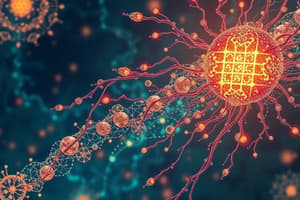Podcast
Questions and Answers
What occurs during an action potential in terms of membrane polarity?
What occurs during an action potential in terms of membrane polarity?
- The membrane maintains its resting potential throughout the process.
- The inside of the membrane becomes negative while the outside becomes positive.
- Both the inside and outside of the membrane become equally positive.
- The inside of the membrane becomes positive and the outside becomes negative. (correct)
How many reversals of polarity are involved in an action potential?
How many reversals of polarity are involved in an action potential?
- Two reversals of polarity. (correct)
- One reversal of polarity only.
- Four or more reversals of polarity.
- Three distinct reversals of polarity.
Which of the following ions is primarily involved in the depolarization of a membrane during an action potential?
Which of the following ions is primarily involved in the depolarization of a membrane during an action potential?
- Calcium ions (Ca²⁺)
- Sodium ions (Na⁺) (correct)
- Chloride ions (Cl⁻)
- Potassium ions (K⁺)
What is the effect of hyperpolarization on a membrane potential?
What is the effect of hyperpolarization on a membrane potential?
Which statement about membrane potential is true?
Which statement about membrane potential is true?
Flashcards
Action Potential
Action Potential
A rapid change in the electrical potential across a cell membrane, where the inside becomes briefly positive relative to the outside.
Depolarization
Depolarization
The process of making the inside of a cell more positive, bringing it closer to the threshold for an action potential.
Hyperpolarization
Hyperpolarization
The process of making the inside of a cell more negative, moving it further away from the threshold for an action potential.
Ion Movement
Ion Movement
Signup and view all the flashcards
Two Reversals of Polarity
Two Reversals of Polarity
Signup and view all the flashcards
Study Notes
Action Potential Overview
- Action potential is a rapid change in membrane polarity
- Inside of the membrane becomes positive, outside becomes negative
- Two polarity reversals are characteristic of the process
- Ions are crucial for membrane depolarization and hyperpolarization
Studying That Suits You
Use AI to generate personalized quizzes and flashcards to suit your learning preferences.




